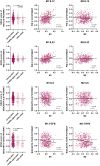Association Between Interleukin-12 and Sarcopenia
- PMID: 34040414
- PMCID: PMC8140914
- DOI: 10.2147/JIR.S313085
Association Between Interleukin-12 and Sarcopenia
Abstract
Background: Emerging studies have proposed that cytokines secreted following macrophage polarization may contribute to skeletal muscle aging. The current study primarily aimed to determine whether these cytokines have an impact on the progression of sarcopenia in an elderly population.
Methods: In total, 120 elderly adults aged 65 years and older who underwent health examinations from 2015 to 2019 were included in this retrospective study. Sarcopenia was based on the criteria proposed by the European Working Group on Sarcopenia in Older People in 2019. Macrophages and cytokines datasets were obtained from Gene Expression Omnibus (GEO) database. Comprehensive assessments were performed for muscle strength, muscle mass, gait speed, tumor growth factor-β (TGF-β), and interleukin-12 (IL-12). Thereafter, the association between sarcopenia and cytokines was analyzed using regression models.
Results: Low muscle strength and low-speed gait were negatively associated with IL-12 [β: -8.96 (95% CI: -14.12, -3.79) and -7.16 (95% CI: -12.54, -1.78), respectively]. Participants with more sarcopenia components and more severe sarcopenia had lower IL-12 (P for trend < 0.001). Conversely, more amount of sarcopenia components were associated with increased TGF-β (P for trend < 0.05). A definite diagnosis of sarcopenia was associated with decreased IL-12 and increased TGF-β with β of -8.96 (95% CI: -14.12, -3.79) and 147.75 (95% CI: 36.27, 259.23). Furthermore, increased IL-12 levels were significantly associated with reduced occurrence of sarcopenia with and odd ratio (OR) of 0.36 (95% CI: 0.15-0.834).
Conclusion: Our findings on the relationship between cytokines and age-related muscle loss showed that IL-12 may be an early diagnosis indicator for sarcopenia in the elderly population.
Keywords: IL-12; TGF-β; gender; macrophage; sarcopenia.
© 2021 Chen et al.
Conflict of interest statement
The authors declared that they had no competing interests.
Figures





References
LinkOut - more resources
Full Text Sources
Other Literature Sources

